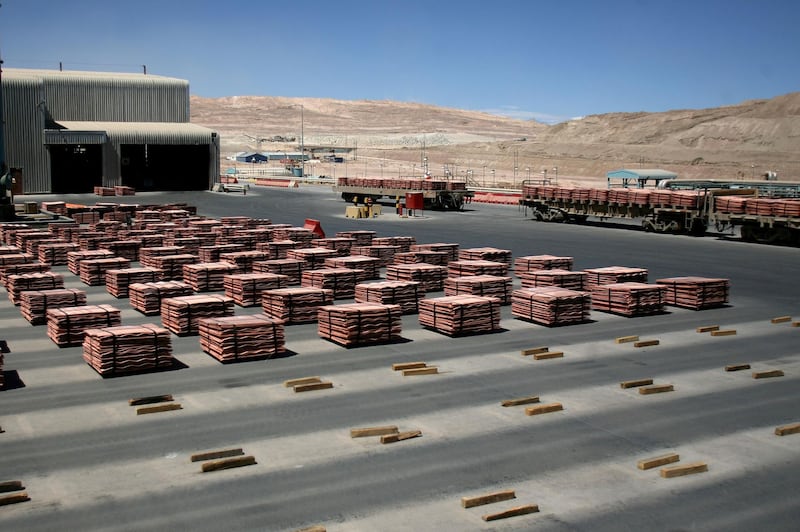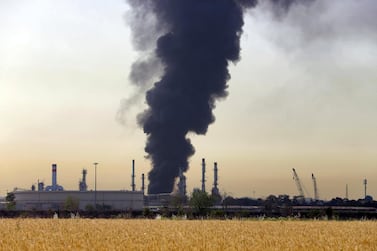Four thousand years ago, the early civilisation of Sumeria in southern Iraq imported their copper from the land of Magan, which covered parts of the modern UAE and Oman.
The metal was one of the two ingredients that make up the alloy bronze, whose tools and weapons gave them mastery over nature and other people.
Now, the transformation of global energy makes copper a crucial commodity once more.
The metal – along with lithium, cobalt, rare earth metals and a few other substances – is one of the “critical minerals” that have emerged as crucial to the transition to new energy systems.
The reddish metal is an excellent electrical conductor that cannot be easily replaced.
It has been used in large quantities throughout history but its demand is set to rise steeply: an electric car needs five times as much copper as a petrol or diesel-powered vehicle and a single wind turbine requires 4.7 tonnes.
The metal is essential in electric wiring for an “energy transition” from combusting fuels to relying on electricity for travel, heating and industrial processes.
The other minerals all have their specific uses: lithium in batteries for cars and renewable electricity back-ups in power grids; silver in electronics and solar cells; graphite, cobalt, nickel and manganese in batteries; rare earths in powerful magnets for wind turbines and electric cars; zirconium, platinum and palladium in fuel cells and electrolysers for making hydrogen.
Much commentary has focused on the geopolitical role of these critical minerals and the dominance of China in mining and processing many of them, particularly rare earths.
At times, misleading analogies are applied to the 20th-century dominance of oil geopolitics.
However, the most serious and imminent problem for the green energy revolution is more straightforward: a simple lack of supply, which is causing prices to rise.
Already, a tripling of prices for steel and polysilicon, along with higher copper and freight prices, has begun to push up the cost of solar systems.
This is not for lack of minerals in the ground – unlike the supposed reasons for the “peak oil supply” scare of the early 2000s.
As with the China-driven commodity boom of those years, it represents the collision of insufficient investment with a sudden surge in demand.
Post-coronavirus pandemic stimuli and easy money are set to feed traditional uses of metals along with ambitious zero-carbon plans.
Capital spending on all mining peaked in 2012 at more than $200 billion annually. Industry investment was barely half that last year and is expected to fall further.
Big mining and resource extraction companies, including oil entities, are responding to shareholder imperatives to return cash, not expand output.
New mines, such as those in Chile, the world’s leading producer, have significantly lower ore grades. Governments from Jakarta to Kinshasa are tightening their grip on the industry, raising taxes and local processing requirements.
Copper supply is adequate for now but it looks tight by the middle of the decade.
Copper is particularly visible because it is already a huge business. Designing and constructing a new mine worth several billion dollars will tax the human and financial resources of even a big company and its engineering contractors.
Most of the other critical minerals were niche commodities until quite recently. For instance, while the combined market for copper, nickel, lead and zinc was worth about $111bn last year, all rare earths were valued at only $3bn, lithium $4bn and cobalt $7bn.
A wild ride of surging demand, new mines, price increases and crashes is almost guaranteed and could eventually deter both mining investors and low-carbon energy adopters.
The US administration of Joe Biden recognises the tension at the heart of its green agenda but it does not want to expend political capital on expanding domestic mining, given opposition from environmentalists and local communities.
Instead, it wants to rely on allies. However, Europe is an even less favourable place to start new mines quickly.
That leaves Brazil, Canada, Australia and some other mostly African countries as the likely options.
What are the solutions? Higher prices will certainly drive mining of lower-grade or more remote or difficult deposits.
Seabed mining has great promise but is in its infancy and may be ecologically damaging for the barely known abyssal depths.
There is growing interest in recovering lithium and other minerals from geothermal and oilfield brines in Germany’s Rhine Valley, western Canada and the Permian Basin of West Texas.
The leftover saline residue from desalination is another potential source that could be of interest in the Gulf.
Recycling should be greatly stepped-up and products such as consumer electronics designed better.
About 95 per cent of minerals in a smartphone can be recovered but only 3 per cent are currently recycled properly.
Still, given the enormous planned growth of new energy systems, recycling is only a small part of the solution for now.
Rare and costly minerals can be substituted with others, for instance, copper with aluminium and lithium in batteries with aluminium, sodium or zinc. These alternatives are so far not commercially available or their performance is poor.
This is a crucial conundrum: how to obtain the new energy minerals to save the climate without ripping up landscapes and communities.
The efficiency of material use and recycling are one element. Another is for miners to clean up: cut greenhouse gas emissions and other pollution, limit environmental damage, engage more responsibly with society and avoid corruption.
At the same time, environmentalists should recognise that new mines are essential and not only in remote developing countries.
Squaring this circle needs research and development into new, more sustainable materials, technology and resource extraction.
The ancient copper miners of Magan profited from their part in forging a new civilisation. The green energy future offers even greater rewards to those who can supply its building blocks responsibly.
Robin Mills is chief executive of Qamar Energy and author of The Myth of the Oil Crisis







